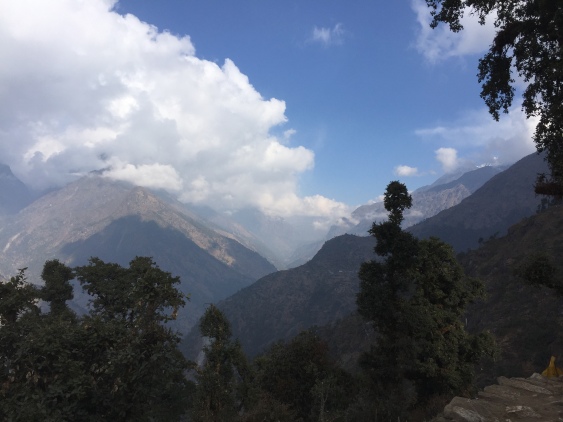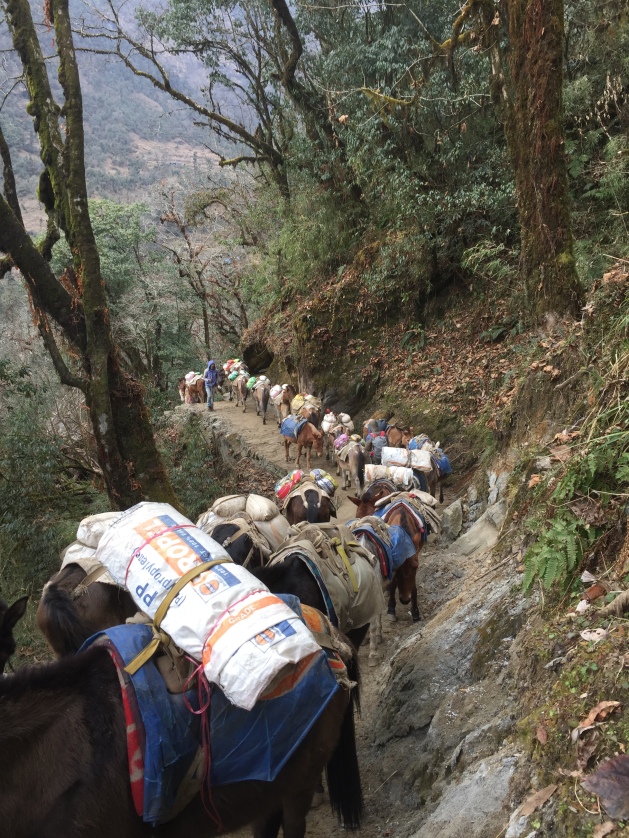Sometimes the contrast between the real and painful effort made during the trek and the imaginative mental projection of finally crossing the highest pass, and the way we compensate in planning how to present this ´triumph´to others, makes one think that one purpose of trekking is to bleach out all pretence and vainglory, vanity and self-aggrandizement.
Live in the moment; do not anticipate; obey one´s guide; do not use imagination to falsely elaborate or boast.
Pilgrimages have always been inner journeys as well as outer treks. Perhaps this trek will also produce insight. It is always a departure from set routine, and in this case choosing to start the journey on Christmas Day, is a deliberate dislocation from the Western end of year and new year routines.
On the second night, we met Dave, a lone British trekker carrying only a 10kg rucksack, in the lodge at Bupsa. He was on his way out after having done the Three Passes route (all over 5000m). An impressively fit figure in his mid 50s, he admitted to having trained for three months to get ready for this challenge. After 30 days he was happy to conclude the trek.
I explained that I was uncharacteristically drained of energy at the start of the trek. Why was this? We agreed it was just altitude. Salleri is about 2200m and the first day involves going up to almost 3000m; this is a much steeper and higher start than the Annapurna trail. It had been a surprise having dizzy spells even walking downhill.
A note about the terrain of the walk up the valley: it is the great Dudh Khosi Nadi (milky river) gathering all its tributaries and flowing south from the heart of the Solu Khumbu, that is intersected at right angles by water courses, thus causing the path to rise up and over the passes, the Taksindu La, Kari La, and Chutak La, all about 3000m, then fall down, even as far as the valley floor in Surke below Lukla. This will continue, but with milder variations until a great rise from the valley floor to Namche takes us up into the higher region. Here the perspective is looking north, up the Dudh Khosi.

The mule trains are coming up and down, causing us to pause: a mule can inadvertently push you off the path, so it´s best to stay on the inside. A little research about mules reveals that they have some superior qualities than their parents, male donkey and female horse: endurance and pliability. Even so, the shouts and whips of the mule herders are harsh. Meanwhile the beasts seize any moment to pause on the path and leech a little moss from the rocks.

Day 3 was a long 20 kilometre day from Bupsa to Chheplung, where the lodge would´t put on any heating except an electric heater that was more light than heat, thus removing a basic comfort that you expect: the yak dung fueled stoves. But Day 4 was a gentler day to Monjo, and a lodge that would have had a full range of coffees available, if only the operator of the coffee machine had been there. But it had a characteristic dining room as sun lounge that became surprisingly warm while the rays of of the sun were on it. Now for the ascent to Namche, the commercial centre of the Solu Khumbu, where trekkers stay going up as well as going down. The river valley is narrower now, and thickly forested, the river a strangely beautiful hue of green and blue, foaming as befits its name, with ice-encrusted rocks.
Though I have recovered from the weakness, now all my leg muscles are screaming, particularly on descents, and at the end of the day I totter upstairs to the frigid bedroom, feeling this is what age-infirm means and I thought I´d postpone that for another day, perhaps until over the age of 80, and here it is!

Hi, When we trekked to Gokyo last year ( our third trek to the region) we met a couple in Phakding on their third Nepalese trek. they told us the walk up from Jiri was actually the most difficult they had done and they had done some of the passes. I had wrongly assumed that it would be relatively easy but obviously these days to Lukla Chheplung you are ascending a lot of vertical metres. Your post also highlights this. Louise
LikeLike